| Home Page | Solomon August Andrée - Sweden The First Attempt of a Flight to the North Pole by Wilbur Cross with Thorleif Hellbom. |
Airmen Index |
|---|---|---|
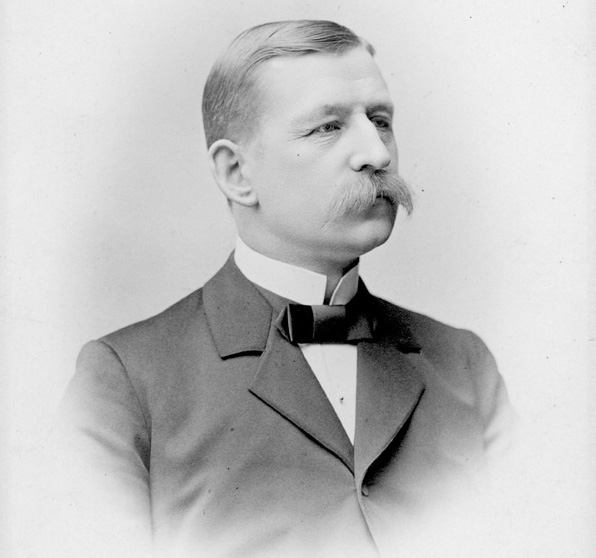 |
||
|
Salomon August Andrée at approximate age of 42. (Photo property of Andréemuseet, Gränna, Sweden.) |
|
Solomon August Andrée, a wiry, intense Swede whose system was constantly supercharged with energy, was only twenty-two when he tasted his first absorbing experience with balloons while working at the Philadelphia World's Fair. From that day on, he began to devote himself to the study of aeronautics. He was an individualist who could pursue one line of thought as tenaciously as a tightrope artist performing on the high wire. Old-line balloonists were astonished that a man so young and inexperienced could take to the air, in varying weather conditions, and never once exhibit any signs of fright.
His first craft was the Svea, which he had persuaded the publisher of Aftonbladet, an evening newspaper in Stockholm, to buy for him, "to promote public welfare and science." From that moment on, ballooning was his mistress, his religion, his entire life. In Svea, he made many significant weather observations, studied the speed and movement of sound, and took some remarkable aerial photographs. His greatest accomplishments in the early 1890's were several daring, and unprecedented, flights across the Baltic Sea. Then, in 1895, Andrée startled his associates by announcing: "It is possible--and feasible--for a balloon to fly to the North Pole!" Even the skeptics listened as Andrée passionately explained just why and how a balloon could forever outmode the plodding, laborious method of packing across the ice on foot or with dogs and sledges. "The winds are steady," he pointed out. "From Spitsbergen, you can almost count on a northerly wind of two weeks' duration. It will carry a balloon across the roof of the world, and beyond to Alaska." "But," came the objection, "how can a balloon stay aloft that long?" Andrée had the answer to this question, too. "In the summertime, conditions would be ideal. Constant daylight would keep the temperature variation within a few degrees. Therefore, the gas would neither expand much nor contract. The result would be a minimum amount of leakage and no need to valve off precious gas because of expansion. By attaching a sail to the bag, a balloonist could increase the speed so that the distance would be covered well within the 15 to 20-day period of buoyancy his craft could have." On May 31, 1896, after more than a year of preparation, the First Andrée Polar Expedition left Stockholm on a tidal wave of patriotic fervor. Andrée hit headlines all around the world as he left for Danes Island, Spitsbergen. Then, for six weeks, the world--and especially Sweden--waited expectantly while the expedition remained weathered in at the advance base. The right wind and weather never came. on August 17, Andrée dejectedly gave up. The balloon was deflated and the expedition crept back to Stockholm in a state of abject depression. Almost overnight, the man who had been labeled a national hero because of his previous, daring flights became an object of criticism and ridicule. He was called a "fraud" by some journalists, a "publicity seeker" by others. Even the most sympathetic newspapers conceded that his chances of ballooning to the North Pole were as limp as the deflated bag. All that fall and winter Andrée brooded. Then, in the spring of 1897, buoyed by new hope and financially backed by the noted Alfred Nobel, inventor of dynamite and donor of the Nobel prizes, Andrée decided on a second attempt. This time, the Swedish government assigned a gunboat, the Svenshsund, to accompany the expedition to Danes Island, with an expert crew to repair the balloon hangar, dig the gas apparatus out of the snow, and help with launching. "We can not fail," said Andrée over and over with an almost pathological insistence, indicating that this time he would get his balloon, The Eagle, airborne at all costs. Accompanying Andrée on the flight would be Knut Fraenkel and Nils Strindberg. Fraenkel was a civil engineer, with considerable Arctic experience. At twenty-seven, he was a mountaineer, gymnast, and railroad builder--a man in the tradition of the old Vikings. Though he had crashed twice while ballooning, he regarded the experience as "rare sport." Strindberg, twenty-four, was more of an intellectual, with a background as a university professor. He was strikingly handsome, a fact that brought the expedition a multitude of female well-wishers. A photographer, he had designed a special reflex camera, in a sealed case, to take pictures as the balloon soared over the polar ice. |
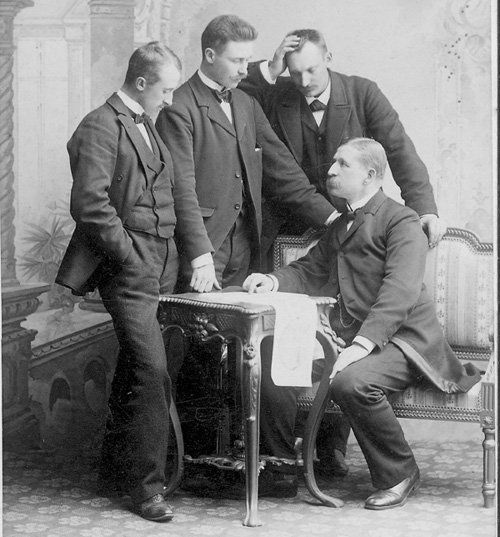
|
|
The expedition crew, from left G.V.E. Swedenborg (substitute), N Strindberg (related to famous author August Strindberg),
K. Fraenkel, and S.A. Andrée. (Photo property of Andréemuseet, Gränna, Sweden.) |
|
By mid-June, 1897, Andrée was back at Danes Island with The Eagle, whose bag was 97 feet high and 68 feet in diameter, made from 600 pieces of pongee silk. Maker Henri Lachambre had personally tested all the pieces before stitching and cementing them together. Andrée, in his thorough, meticulous way, had even arranged for two engineers from the Nordenfelt Company to follow each step in the manufacture and to make regular tests. The upper two-thirds of the bag was three-ply, both for strength and reduction of leakage; and the lower third was two-ply. The finished bag was carefully varnished inside and out so that, though weighing a ton and a half because of this extra process, it was supposedly impervious.
More than 380 hempen cords formed a netting over the bag. on the underside, they were woven together to form a dozen ropes, which then passed through a bearing ring shaped from American elm and were secured to the basket. The basket was made of wicker and wood, and designed as a double-decker. on top, in an area about six feet in diameter, was the observation platform, similar to that on most balloons. Below was a compartment which had a mattress and sleeping bag of reindeer skins and was tight and solid enough in construction to serve as a darkroom. Andrée's idea was to develop photographs along the way, and send prints back by carrier pigeon and by cylinders dropped into the sea. In this way, a valuable record of the Arctic would get back to civilization, even if the expedition did not. Around the walls of both decks were small compartments with the wide variety of equipment the three men had gathered: photographic supplies, food, extra clothing, navigational instruments, maps, books, utensils, and other items. Guns and ammunition were fitted into a space in the floor of the lower compartment. The expedition had enough food for an estimated three and a half months. Included were special lemon lozenges to prevent scurvy, a concoction made of 55 pounds of chocolate and pulverized pemmican shaped into solid cakes, and two bottles of port presented to them by the king. There were also 36 homing pigeons, in wicker cages, which had been trained in the Arctic and were supposedly capable of taking messages back to Spitsbergen from any faraway point along the route. Andrée, something of an inventor, had devised a sledge that would come apart to form two, a collapsible canvas boat, and other unique items of equipment. He had also devised a clever system of "automatic ballasting" that did not necessitate valving or throwing sandbags over the side. This consisted of a harness with three heavy coconut fiber ropes, each a little over 1,000 feet long. The ropes, waxed at the lower ends, were supposed to drag easily across the surface of water and ice, their combined weight being enough to pull the balloon down about 10 feet for each 20 feet of length the aeronauts hauled into the basket. In the standard trailing position, the ropes would hold The Eagle at about 600 to 700 feet as she rode. Despite Andrée's foresight and attention to detail, the balloon had one dangerous flaw: she leaked. While in the shed being readied for flight, it was found that she lost about 35 cubic meters of gas per day. Andrée tried to stop the leakage by varnishing the seams, but without much luck. The advice of everyone, including the balloon maker himself, was that the expedition should be postponed and the bag rebuilt. "I do not have the courage to postpone the flight again," Andrée replied, remembering the ignominy of the year before. He was strongly supported by both Strindberg and Fraenkel, even though it had been demonstrated that The Eagle was losing a lift capacity of 99 pounds every twenty-four hours. On July 11, 1897, at 2:30 in the afternoon, the flight order was given. "Strindberg! Fraenkel!" The three men climbed into the basket, reaching out to give last handshakes to the men on the ground. "Cut!" shouted Andrée. A sailor took his knife to the anchor rope. "Oh, hell!" the man muttered as the blade nicked his finger. Andrée leaned over the basket at the exclamation. "Hell--that is where we are going," he retorted as the balloon leaped skyward. |
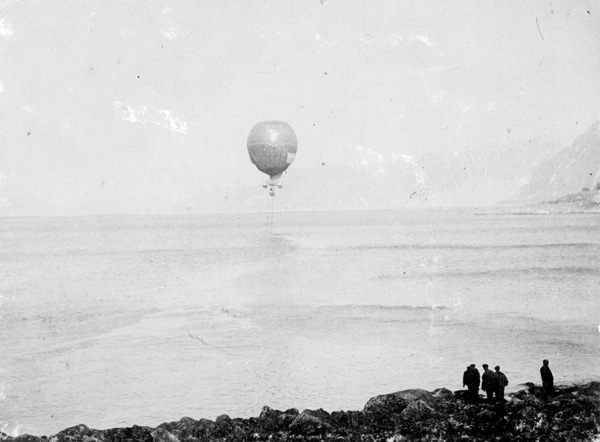
|
|
The crew of the Eagle departs 11, July 1897. Their fate remained unknown for thirty-three years. (Photo property of Andréemuseet, Gränna, Sweden.) |
|
The Eagle wobbled erratically as the wind caught the sail, and headed northward. Passing over the shore, one of the three long trailing ropes caught on a rock. Snagged, the balloon dipped dangerously, so low that the bottom of the basket touched the water. Andrée and his companions struggled to maintain their balance. Then the balloon righted itself again, as the trailing line yanked free, losing a whole section of the end, and the bag began to rise. For almost an hour The Eagle could be seen against the gray north sky, growing smaller and smaller.
Then it vanished and was never sighted again. In August of 1930, the curious discovery by the men on the little Norwegian sealer Bratvaag was slow in reaching the outside world. The skipper wanted to complete one of the most profitable fishing cruises he had ever enjoyed. So word of the find was shouted across to one Capt. Gustav Jensen, whose ship, the Terningen, was sighted a few days later. When Jensen reached port, his statements touched off a large journalistic bomb. Newspapers of all nations frantically began hiring small steamers to go to look for the Bratvaag, to get the first story. Radio appeals were made (the Bratvaag had a receiver, but no transmitter), pleading with the skipper to meet at a designated mid-ocean rendezvous and give the sender an "exclusive" for which his editors would pay a whopping price. When two weeks went by with no contact, reporters began hinting that Captain Jensen of the Terningen had concocted the whole story for publicity or that the relics discovered had nothing to do with the Andrée expedition. Finally, on September 3rd, The New York Times headlined the true significance of the story: "BODIES OF AIRMEN LOST 33 YEARS FOUND NEAR WHERE BALLOON FELL IN ARCTIC." During the next few days, the story was patched together. There was no doubt that the relics on White Island were from the Andrée Expedition: the canvas boat, a sledge, some food, a rusty rifle, clothing, a cookstove, and a camera, still loaded with film. Two skeletons had also been found, still dressed in furs. One was Andrée's, leaning against a supporting ledge of rock; the other was that of Strindberg. The bones of Fraenkel were not found until a few weeks later, when further searches were made at White Island. Most important of all, there was a diary. Now the-entire world waited to see whether the writing was still legible, after 33 years under the snow; and, if so, whether the pages contained a complete record of the struggle. Andrée, even in his dying hours, had fortunately practiced the same meticulous care that had been characteristic of his life. He had padded the diary in straw, then sealed it as tightly as possible in oilcloth. Even as he died, the book was clutched to his chest, inside the protective clothing he wore. Its recordings were as nearly complete as anyone could have wished. All Sweden rejoiced that the greatest of all Arctic mysteries would be solved: How had the three men met death? But the mystery was not solved. If anything it was intensified. There was no reason at all why the explorers should have perished when and where they did, no more reason than had they been on a camping trip in the Kjolen Mountains of northern Sweden. On July 11, 1897, three hours after the start of the flight, the three explorers were in high spirits. The barometer was rising, the wind steady, though with a slight drift to the east. Andrée was not worried about the drift. With proper handling of sail and trailing lines, The Eagle could be steered at an angle as much as 30 degrees to the right or left of the true wind direction. Andrée decided, with his usual restlessness, that it was time to send some messages to the outer world. Consequently, he wrote four notes and tied them to four of his carrier pigeons. Later, he placed another message in a metal cylinder and dropped it over the side. It read. Buoy No. 4. The first one dropped. July 11, 10 P.M. G.M.T. So far our trip has gone well. We continue at a height of about 250 meters, with a course at first north 10 degrees east, true, but later north, 45 degrees east, true. Four carrier pigeons were dispatched at 5:40 P.M. Greenwich time. They flew westward. We are now over ice, which is much broken in all directions. Glorious weather. Excellent spirits, Andrée, Strindberg, Fraenkel. Above clouds since 7:45, G.M.T. A second buoy, less than an hour later, showed that The Eagle had risen to about 1,800 feet and was at about 82 degrees of latitude and 25 degrees longitude east. The balloon's speed was remarkable. |
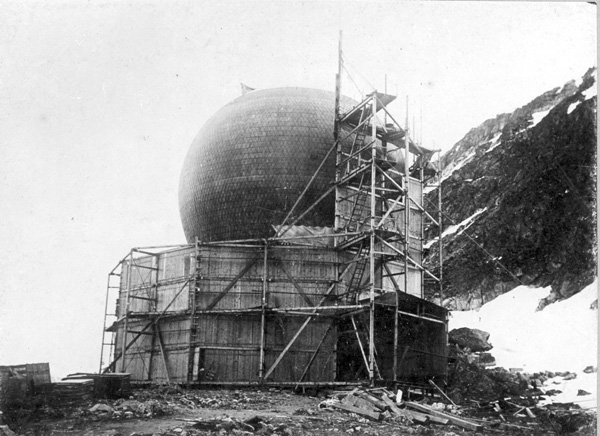
|
|
The Eagle ready for ascension in the balloon house at Danes Island, Spitsbergen. (Photo property of Andréemuseet, Gränna, Sweden.) |
|
Hour after hour passed, with a monotony that quickly replaced the initial exhilaration of the start. There was nothing to do but eat and sleep. Below, the Arctic wastes had a hypnotic sameness, one ice floe after another, sometimes jammed together by wind and currents, at other times broken up, with patches of dark water showing through. The three men wrote their observations and made notations about the temperature, the wind, the weather. But, with continual daylight and almost no change in weather conditions, there was little to record.
On the third day out, Andrée wrote another note and attached it to several carrier pigeons: From Andrée's Polar Expedition to Aftonbladet, Stockholm. July 13, 12:30 noon. Lat. 82 degrees, 2'. Long. 15 degrees, 5' East. Good passage each 10 degrees south. All well on board. This is the third pigeon post. Andrée. This was the only carrier pigeon message ever received. That day, the men began to hear a disturbing sound: the crackling of ice, forming a thin veneer over the fabric and breaking off in small sheets. Slowly the weight increased, pushing the balloon lower--so low that finally the bottom of the basket touched the ice hummocks for the first time. Like a ball, the balloon bounced up to 500 feet, then slowly settled again. The afternoon of the third day was the beginning of the "Hell" that Andrée had prophesied in his caustic final remark as the flight started. Hour after hour, The Eagle continued its exhausting cycle: rising, falling, dragging the gondola for long stretches over the choppy ice, then rising again as the men jettisoned ballast. From later evidence, from correspondence with the explorer, Fridtjof Nansen, and from remarks he had made, Andrée had known for many weeks that the flight would be a failure. Perhaps he had pictured at least reaching the Pole and being able to send out one glorious message by pigeon and buoy before vanishing forever. But he had never anticipated trouble so soon. It was ironic that the balloon carried a preposterous collection of entirely useless objects, many of which the three men clung to when all hope of flight had ended and they were forced to march across the ice. These included quantities of Russian and U.S. money in silver and gold, a white dress tie, an expensive porcelain bowl, the heavy silver base for a German vase, a white shirt in its original wrappings, a large collection of heavy towels, old newspapers, packets of personal letters, and two tickets to the Stockholm Exposition of 1897. On July 14, The Eagle unaccountably rose for a few hours, perhaps because of a temperature change. But by afternoon, luck ran out. The constant jolting had loosened an escape valve and hydrogen could distinctly be heard hissing out above the heads of the three men. The Eagle's lifeblood was draining away, and nothing could be done about it. By 7 P.M. that day, after a long, punishing drag over the sharp ice hummocks that threatened to rip the gondola to shreds and matchwood, Andrée gave the order which all three knew was inevitable: "Get ready to open the rip valves." By 7:30 they were down for good, untangling the ropes on an ice floe, trying to furl the sail so it would not catch the wind, and despairingly watching the great bag grow limper and limper as it settled down into a great dark blob of fabric. There was one small blessing: for the first time in four days, the men slept soundly, securely wrapped in sleeping bags and canvas. For the next seven days, the men camped at the scene of the landing, sorting out their equipment, readying the sledge, and putting together the collapsible canvas boat. There was one great decision to make: which direction to march in? The men used the time in trying to determine the drift of the ice. The obvious course would have been to head south, and slightly to the west, toward North East Land off Spitsbergen and the Seven Islands, where there were known to be caches of food and supplies. Instead, for a reason that will never be known, they headed almost due east, toward the barren, and little known, Franz Joseph Land. Perhaps, since the wind had carried The Eagle much farther eastward than estimated, Andrée was convinced that the moving ice would also carry them east. on July 22, eleven days after the glorious start from Danes Island, Andrée, Strindberg, and Fraenkel began their laborious march across the ice pack. The difficulties were overpowering. The men kept slipping into pools of melting ice; the sledge runners caught on hummocks; breaks in the ice made it necessary to go hundreds of yards out of their way to avoid open water; the constant glare of twenty-four hours of daylight made their eyes bloodshot and blackened their skin wherever it was exposed. To make matters worse, the general drift of the ice was now seen to be westward, taking them farther and farther from their objective each lay. |
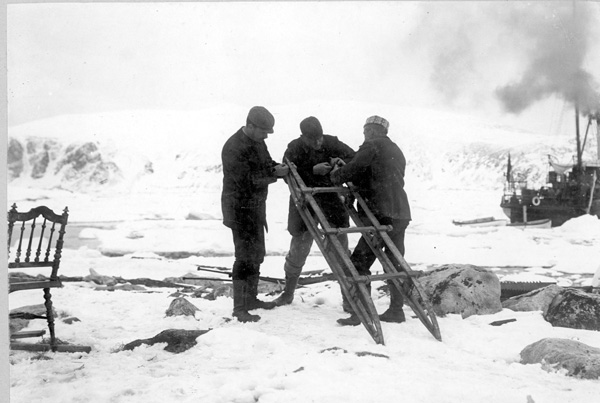
|
|
Control of equipment, in this case a sledge, from left Strindberg, Andrée, Swedenborg. (Photo property of Andréemuseet, Gränna, Sweden.) |
|
"We will have to change the direction of march," said Andrée finally, not giving in to the elements until August 4. They had already abandoned a few things each day, and a whopping 220 pounds of baggage on July 27. "We will make for the Seven Islands."
On taking observations in his diary, he noted that they were then at Latitude 82:7 North and Longitude 22:43 East. During almost two weeks of plodding, therefore, they had progressed about 60 miles from the point of landing. With feet cut and frostbitten, and arms bruised from many slips and falls on the ice, the men found it a relief to arrive at open water somewhere off North East Land. They stowed their gear in the canvas boat and set out with paddles and oars. Then the whims of the elements caught them again. Suddenly the current changed from westward to southeasterly. Again they saw their objective, the Seven Islands, fade away. From September 12 to 17 they drifted, partly on open water, but mostly encamped on floes. The days were beginning to shorten. The nights became pitch dark and brought bitter cold and dangerous squalls. On September 17, they sighted the first land in 68 days--White Island. Working toward it frantically, on foot and by boat, they paused long enough to make two important kills: a seal on September 18, a bear (Andrée's diary refers to bears as "the wandering meat shops of the Arctic") On September 20. They also took time for as weird a celebration as has ever been recorded in polar history. The details were found in the remains of Strindberg's diary. This was a feast of "seal steak, seal liver, seal brains, seal kidneys, butter, and Swedish bread, gateaux aux raisins, with raspberry sauce, and port wine for dessert." The wine was the gift of King Oscar II, vintage 1836. With it, they drank a toast to the king, unfurled a small Swedish flag carried for the occasion (or any other that might arise), and made the Arctic wastes echo with the National Anthem, sung at the top of their lungs. A day later, the triumph of approaching land was shattered when the ice beneath them suddenly started to break up. Part of their supplies were thrown into the water. A small hut like shelter they had erected against the night's cold was torn apart. But somehow they all escaped alive, managed to salvage a good part of their equipment (Andrée had insisted on having sinkable items lashed, whenever possible, to floatable ones), and eventually reached land. Drenched, exhausted, and frozen, the three men began the last phase of their historic ordeal. They actually reached White Island with enough food, shelter, and equipment to survive from that first week in October, when they set foot ashore, through the winter. They had already conquered the worst hardships--weathering out some 11 weeks on the dangerous, shifting ice. It only remained now to hold out until the winter ice became firm and they could sledge across some so miles to North East Land, where they would find natives and shelter. For a week, the three men had been suffering stomach cramps, diarrhea, and other intestinal upsets. They were badly weakened, constantly in pain, and often too exhausted to cook the rich polar bear meat they had saved from their recent kill. They had, however, a small primus stove, in such good condition and with enough fuel remaining that it was actually operated when found 33 years later. Andrée's diary does give a clue to one death, that of Nils Strindberg who was the first to go. Shortly after the three men had pushed and tugged the sledge and the canvas boat across the rocky shores of the island, Strindberg was seized by what the other two men decided was a heart attack. He died within a few hours. The last entry in Strindberg's diary, on October 6, was "Resignation." Andrée and Fraenkel lived about two weeks longer. The condition of the camp, with no real shelter constructed and with equipment strewn around, indicated that the two men were too weak to work. It was contrary to Andrée's nature that he should have left valuable instruments and ammunition in the canvas boat, where they were found by the Bratvaag sailors in 1930; or that he would not have used loose rock to construct a wall for protection against the wind and the cold. And so the record fades away, rather than ends. For the last few entries in Andrée's diary are indecipherable, and the last recognizable date is October 17. Knut Fraenkel died in his sleeping bag, and Salomon August Andrée died propped against a rock. The Great Adventure had ended. |